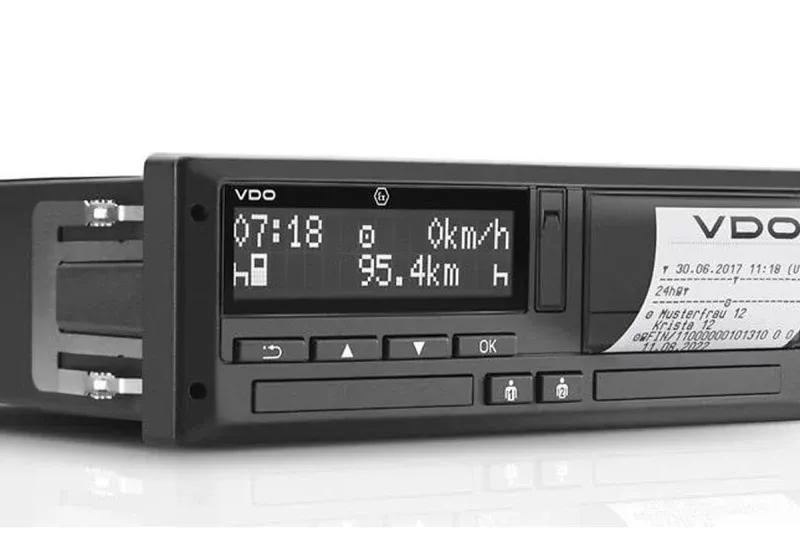The latest generation tachographs, known as the ‘Smart Tacho’, is becoming the new standard. All new trucks and busses that are first registered after June 15 2019 should be equipped with this new tachograph. This means that every transport company needs to adapt. In this article, we point out the most important changes that come with the Smart Tacho.
In order to download the files of this new generation tachographs, you must upgrade your download equipment. If you don’t have any smart tachographs in your fleet yet, you do not have to take action yet. But as soon as your fleet is renewing, you should upgrade.
If you use Remote Tacho Download from FleetGO, you don’t have to worry; all our systems are compatible with the newest tachographs. Read more about Remote Tacho Download.
All new vehicles will get a Smart Tacho
All new trucks are equipped with the Smart Tacho (read more about all functionalities here). This means that as soon as your fleet is renewing, your company will have to deal with this new generation of tachographs. The new tachograph has an improved technical infrastructure to prevent fraud and increase the simplicity of road side inspections.
Road side inspections will increase
The new DSRC interface (Dedicated Short Range Communication) makes it possible for monitoring bodies to read out data at a (short) distance that helps to detect possible fraud. This interface serves purely as a preselection tool to decide if further inspection is needed.
If no indications for fraud have been found, any data collected via DSCR shall be deleted after 3 hours. General road checks can still take place without this preselection.
With this new preselection tool, the monitoring authorities can inspect much more vehicles at once than with a general inspection. More important: if a truck is selected for further investigation, it’s most likely that there’s something wrong with the tachograph data, which means that the chances of getting fined increase massively.

Within 15 years, every EU country must inspect with DSRC
The new monitoring system with DSRC is mandatory in all EU countries within 15 years from June 15, 2019. So from June 15 2034 it means that all trucks that drive internationally must be equipped with the Smart Tacho.
Trucks that only drive domestic, can still use the ‘old’ generation of digital tachographs.
GPS positions recorded every 3 hours
The Smart Tacho registers the GPS position from the start of the shift, the end of the shift, and every 3 hours during the shift. The GPS location is an extra security layer to check if the locations are logical within the driving times.
The security of the speed pulse (KITAS) is improved
To make manipulation more difficult, the KITAS sensor, an encoder/sensor on the gearboxf which gives the speed pulse to the tachograph, got improved security measures. With the updated version it’s easier to see if the sensor is opened (tamper proof). Next, the connection between the KITAS sensor and the tachograph can only be carried out once: the new KITAS can only be paired once to a tachograph. If the tachograph needs to be replaced, the KITAS sensor also must be replaced. Only when the KITAS sensor alone is defect, it can be replaced.
Drivers won’t need a new driver card
All drivers that use a Smart Tachograph, don’t have to upgrade their driver cards. Their current card will work fine in the Smart Tacho. The only difference is that the extra data that is recorded (like the GPS location) can’t be stored on the old cards. The drivers that must renew their cards, get a new generation card which can store this data. These new generation cards are backwards compatible, so they will work on all types of digital tachographs. All driver cards remain valid for 5 years.
The company card is valid for 5 years instead of 2
Just like the driver card, the new company cards are valid for 5 years instead of 2.
The overall costs of tachographs will increase
With the improved security on the hardware infrastructure, tachograph workshops have upgraded their calibration equipment and invested in trainings to be certified to work on the new tacho. Also, with the infrastructure of KITAS and tachograph, a replacement of the tachograph results in the replacement of the KITAS sensor. Both items will eventually lead to more overall costs.
Data usage and privacy
All recorded data that is obtained before or during a road side inspection may contain privacy related data. It’s good to know that this data can and may only be used for the time of the actual road side inspection and should be erased within 3 hours after the inspection unless there are clear signs of misuse or fraud.
Transport companies that work with Smart Tachos, are required to formally inform their truck drivers about the fact that these remote road side inspection are possible.
ITS opens doors to integration
With the new ITS interface (Intelligent Transport Systems), companies are able sharing vehicle data or other data with third party systems. For example, download systems, on-board computers and mobile apps too. This feature opens doors to powerful integrations for now and in the future.
And what about automatic fines?
With the new DSRC function, it’s possible to also introduce a system automatic fines. While this is theoretically possible, the EU has decided to postpone this. For now…



